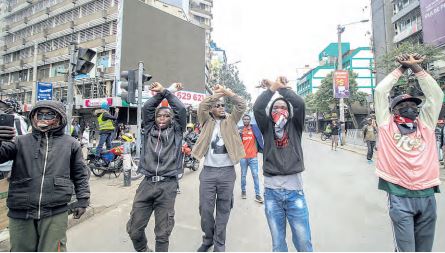
The protests currently shaping Kenya’s political, digital and social landscape are a dynamic expression of Albert O. Hirschman’s Exit and Voice theory. In his seminal 1970 book, Exit, Voice, and Loyalty: Responses to Decline in Firms, Organizations, and States, Hirschman explores how individuals or groups respond to dissatisfaction within organisations, institutions, or states.
Faced with dissatisfaction in governance, Kenyan youth are choosing “voice” over “exit”, signalling their refusal to disengage from a system they believe can be reformed.
While some see these demonstrations as a threat to stability, they are, in fact, a hallmark of a vibrant democracy and an invaluable opportunity for President William Ruto’s administration to strengthen governance.
Protests have long been a cornerstone of democracy, providing a mechanism for citizens to express grievances and demand accountability.
The youth protests signify political maturity and a population deeply invested in its governance Kenya’s youth are engaging actively in the political process.
This is crucial for a thriving democracy. It holds leaders accountable, ensures diverse perspectives are heard, and fosters transparency. Youth-driven activism, whether on the streets or through digital platforms, amplifi es issues that might otherwise remain under the radar.
These protests refl ect an electorate unwilling to accept the status quo, challenging leaders to responsive over reactionary accountability.
Moreover, youth movements are often precursors to signifi cant political and social transformations. From the civil rights movements in the United States to recent pro-democracy protests worldwide, youth have consistently played a pivotal role in shaping more inclusive and just societies.
Kenya stands on the cusp of such potential, with its youth poised to drive reforms that could redefine its democratic and governance ethos. For President Ruto, these protests are not merely a challenge but, rather, a strategic opportunity.
Harnessing the energy, passion, and innovation of Kenya’s youth could transform what appears to be a political liability into a formidable strength.
Here are actionable strategies his administration can adopt: the first step is to acknowledge the grievances fuelling these protests. Rather than dismissing or repressing dissent, the government should create platforms for structured dialogue.
Town halls, youth forums, and consultative meetings can bridge the gap between policymakers and young citizens. By actively listening and responding to their concerns, the administration can demonstrate a commitment to participatory governance. Protests often stem from systemic issues, and Kenya’s youth movements are no different.
Unemployment, economic disparity, and perceived government ineffi ciencies are at the heart of their frustrations. The administration must prioritise policies that address these root causes.
Investments in job creation, youth entrepreneurship programmes, and equitable service delivery would not only alleviate immediate concerns but also build long-term trust in government institutions. Kenya’s youth are digitally savvy, and much of their activism is amplifi ed through social media.
The government can tap into this by fostering online civic engagement. Regular updates on policy progress, live Q&A sessions with offi cials, and digital platforms for submitting suggestions can turn online dissent into constructive dialogue.
Youth inclusion in decision-making is critical. Appointing young leaders to key positions, consulting youth organisations in policy formulation, and ensuring representation in governance structures can foster a sense of ownership and accountability.
When young people see themselves refl ected in leadership, their inclination toward voice strengthens, while the temptation to exit diminishes. e administration should publicly recognise youth protests as a sign of democratic health rather than instability.
Acknowledging their legitimacy and addressing concerns constructively would project an image of a government that values and respects its citizens.
This approach not only strengthens domestic legitimacy but also bolsters Kenya’s reputation as a democratic leader in the region. Calling them treasonous, deranged or worse, accusing parents of poor parenting skills only makes a bad situation worse. Repression of protests risks alienating the youth further, pushing them toward exit strategies such as emigration or disengagement from the political process.
Worse, it could fuel radicalisation or unrest, undermining stability. By contrast, embracing protests as an opportunity can transform Kenya’s governance landscape.
For President Ruto, the path forward lies in leadership that is empathetic, responsive, and inclusive. By addressing the structural challenges that give rise to dissent and fostering an environment where youth feel heard and valued, his administration can convert the energy of protests into a catalyst for progress.
The youth protests are a call to action for both the government and society at large. They underscore the urgency of addressing systemic issues while reaffirming the importance of democratic principles.
Far from being a threat, these movements are an opportunity to strengthen governance and build a more inclusive, equitable Kenya.
President Ruto’s administration has a godsend opportunity to lead by example, showcasing how a government can turn dissent into dialogue and protests into progress.
By doing
so, Kenya can set a powerful precedent for the continent, proving that
the voice of the youth is not a threat
to democracy but its very lifeblood.






![[PHOTOS] How Ruto was received in China](/_next/image?url=https%3A%2F%2Fcdn.radioafrica.digital%2Fimage%2F2025%2F04%2Ff567f368-47e4-4dc8-b04d-d034d30fb71a.jpeg&w=3840&q=100)

